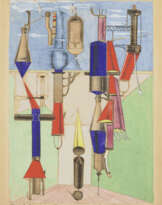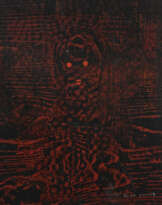ID 929401
Лот 1 | Max Ernst (1891-1976)
Оценочная стоимость
€ 200 000 – 300 000
Les Deux Oiseaux
signé 'max ernst' (en bas à droite)
huile et gesso sur papier de verre marouflé sur panneau; dans le cadre d'artiste en liège
Panneau: 26 x 20.5 cm.
Cadre d'artiste: 35.6 x 29.8 cm.
Exécuté vers 1925
signed 'max ernst' (lower right)
oil and gesso on sandpaper laid down on panel; in the artist’s cork frame
Panel: 10 1/4 x 8 1/8 in.
Artist’s frame: 14 x 11 3/4 in.
Executed circa 1925
Provenance
Collection particulière, Paris.
Collection particulière, Suisse (dans les années 1950); vente, Christie’s, Londres, 2 juillet 1998, lot 258.
Collection particulière, Suisse (acquis au cours de cette vente).
Vente, Sotheby’s, Londres, 4 décembre 2000, lot 48.
Collection particulière, Luxembourg.
Barbara Lambrecht, Siegen (acquis auprès de celle-ci en 2001); vente, Christie's, Londres, 28 février 2017, lot 103.
Acquis au cours de cette vente par le propriétaire actuel.
Literature
W. Spies, S. Metken et G. Metken, Max Ernst, Œuvre-Katalog, Werke 1906-1925, Cologne, 1975, p. 386, no. 740 (illustré).
Special notice
Artist's Resale Right ("droit de Suite").
If the Artist's Resale Right Regulations 2006 apply to this lot, the buyer also agrees to pay us an amount equal to the resale royalty provided for in those Regulations, and we undertake to the buyer to pay such amount to the artist's collection agent.
ƒ: In addition to the regular Buyer’s premium, a commission of 5.5%
inclusive of VAT of the hammer price will be charged to the buyer.
It will be refunded to the Buyer upon proof of export of the lot
outside the European Union within the legal time limit.
(Please refer to section VAT refunds)
Post lot text
Représentant un couple d'oiseaux confinés sur un fond de papier de verre, Les Deux Oiseaux s'inscrit dans une série majeure de 'tableaux-objets' qu'Ernst réalise en 1924-25 sur le thème des volatiles en captivité. Cette composition voit le jour alors que l'artiste est sur le point de découvrir la technique du frottage et, à l'instar des travaux qu'il exécutera bientôt selon cette méthode, l'imagerie de la présente œuvre est le fruit d'un procédé quasi-aléatoire. Ici, les motifs élaborés du plumage de chaque animal ont notamment été obtenus par le tamponnement répété d'un objet arrondi sur la peinture polychrome encore humide, afin de produire un effet de maillures.
L'improbable faune qui surgit du tréfonds de l'inconscient d'Ernst au gré de ses expériences avec divers matériaux semble presque émaner des forêts sombres et impénétrables qu'il peint fréquemment durant cette période. Les oiseaux sont les créatures qui reviennent le plus souvent. Ils ont toujours occupé une place importante dans la vie d'Ernst, lui, l'artiste au visage de volatile dont l'esprit a été marqué, dès l'enfance, par une étrange analogie entre les hommes et les oiseaux : un rapprochement mental provoqué par la mort de son animal de compagnie favori (un oiseau nommé Horneborn) le soir même de la naissance de sa sœur Loni. L'incident, se souvient Ernst, suscite « une confusion dans l'imaginaire de ce garçon autrement plutôt sain d'esprit – une sorte de manie interprétative, comme si l'innocente nouveau-née... avait, dans sa rage de vivre, pris possession de l'essence vitale de son oiseau préféré. La crise est vite surmontée. Mais dans la tête de l'enfant demeure une tendance spontanée, bien qu'irrationnelle, à confondre les représentations d'êtres humains avec celles d'oiseaux et d'autres créatures, qui se répercutera dans les motifs de son art » (cité in Max Ernst, cat. exp., Kunsthaus, Zürich, 1962, p. 23).
De nombreux tableaux qu'Ernst réalise entre 1924 et 1925 figurent deux oiseaux en cage, condamnés à partager un espace exigu où il leur est impossible de déployer leurs ailes. Dans Les Deux oiseaux, les volatiles se blottissent l'un contre l'autre, le plus petit se lovant contre le corps du plus grand. La délicatesse de leur forme et des reliefs de leurs plumes tranche nettement avec la texture brute du liège et du papier de verre. Ici, l'expression poétique de quelque chose de singulier et d'infiniment précieux semble avoir été à la fois réprimée et rendue possible par une matérialité dense et terreuse.
La récurrence du thème des oiseaux en cage dans l'œuvre d'Ernst est telle que l'on serait tenté d'y voir quelque résonance avec la vie personnelle de l'artiste. En 1924, Ernst se rend en effet en Indochine afin de sauver le mariage de ses amis Gala et Paul Éluard, avec lesquels il a vécu en ménage à trois pendant plus d'un an jusqu'à ce qu'Éluard, à bout, se réfugie à Saigon du jour au lendemain. Étant parvenu à ressouder le couple, Ernst vit seul au lendemain de cet épisode. Il semble plausible que les tableaux de tourtereaux qu'il réalise à son retour, et qui représentent le plus souvent soit un oiseau solitaire en cage, soit, comme dans cette œuvre-ci, un duo amoureux, reflètent à bien des égards ses états d'âme quant à la rupture et à la reconfiguration inévitables de cette relation qui marqua profondément sa vie.
Depicting two confined love-birds in oil on a sandpaper ground, Les Deux oiseaux is part of a major series of object-paintings on the theme of confinedbirds that Ernst made in 1924-25. It was executed when the artist was on the verge of discovering the frottage technique and, like these works, it makes use of a semi-random technique in order to create its imagery. The elaborate pattern of the feathers of each bird, for example, is the result of repeatedly impressing into the wet surface of the multi-colored oil paint with a blunt object to create a patterned shell-like relief.
The creatures that emerged from the depths of Ernst’s unconscious, through such experimental processes with his materials, came into being almost as if they had walked out from the shadows of the dark, impenetrable forests that he repeatedly found himself painting at this time. Among these, birds were the most common creatures to appear. Birds had always played a significant role in Ernst’s life. Ernst’s features not only resembled a bird, but, since childhood, as he himself explained, he had made a clear subconscious connection in his mind between people and birds. When only a boy, Ernst’s favorite pet (a bird called Horneborn) died during the night. That same night, his sister Loni was born. This, Ernst later wrote, led to “confusion in the brain of this otherwise quite healthy boy—a kind of interpretation mania, as if the newborn innocent…had, in her lust for life, taken possession of the vital fluids of his favorite bird. The crisis was soon overcome. Yet in the boy’s mind there remains a voluntary if irrational confounding of the images of human beings with birds and other creatures, and this is reflected in the emblems of his art” (quoted in Max Ernst, exh. cat., Kunsthaus Zürich, 1962, p. 23).
Many of Ernst’s 1924-25 paintings depict two caged birds, trapped together in close confinement where they are prevented from spreading their wings. In Les Deux oiseaux the two birds huddle close together, the smaller one curling up into the body of the larger one. The delicacy of their forms and of the pattern of their feathers is presented in sharp contrast to the heavy texture of the sandpaper ground and the artist’s cork frame. Here a poetic expression of something exotic and precious seems to have been both constrained by as well as born from a heavy, earthy materiality.
Such was the profligacy of Ernst’s depiction of imprisoned love birds that it is tempting to see these works as a possible expression of his personal life. In 1924, Ernst travelled to Indochina to save the relationship between Gala and Paul Éluard. These were two dear friends with whom Ernst had lived for over a year in a 'ménage à trois until' Éluard had suddenly fled to Saigon in desperation. Now living alone after effectively reuniting Éluard and Gala as a couple, it seems likely that the series of dove paintings that Ernst began to create upon his return, and which more often than not depict either a lone caged bird or, as in this work, a loving couple, to some extent mirror his reflections on the inevitable break-up and reconfiguration of this important relationship in his life.
| Автор: | Макс Эрнст (1891 - 1976) |
|---|---|
| Техника исполнения: | Масло на холсте |
| Категория аукционного дома: | Картины |
| Автор: | Макс Эрнст (1891 - 1976) |
|---|---|
| Техника исполнения: | Масло на холсте |
| Категория аукционного дома: | Картины |
| Адрес торгов |
CHRISTIE'S 9 Avenue Matignon 75008 Paris Франция | ||||||||||||||
|---|---|---|---|---|---|---|---|---|---|---|---|---|---|---|---|
| Предосмотр |
| ||||||||||||||
| Телефон | +33 (0)1 40 76 85 85 | ||||||||||||||
| Факс | +33 (0)1 40 76 85 86 | ||||||||||||||
| Условия использования | Условия использования | ||||||||||||||
| Транспортировка |
Почтовая служба Курьерская служба Самовывоз | ||||||||||||||
| Способы оплаты |
Банковский перевод | ||||||||||||||
| Часы работы | Часы работы
|













